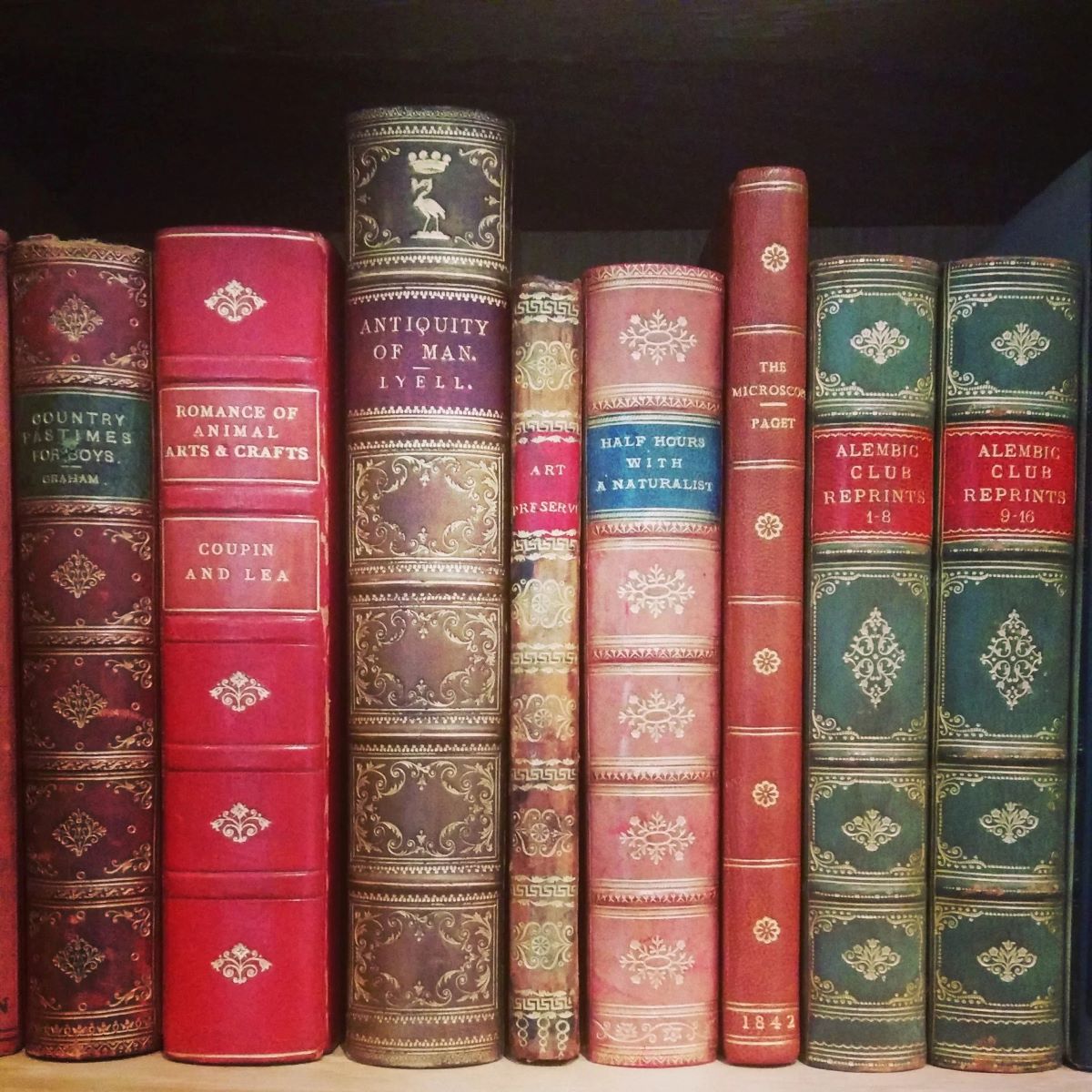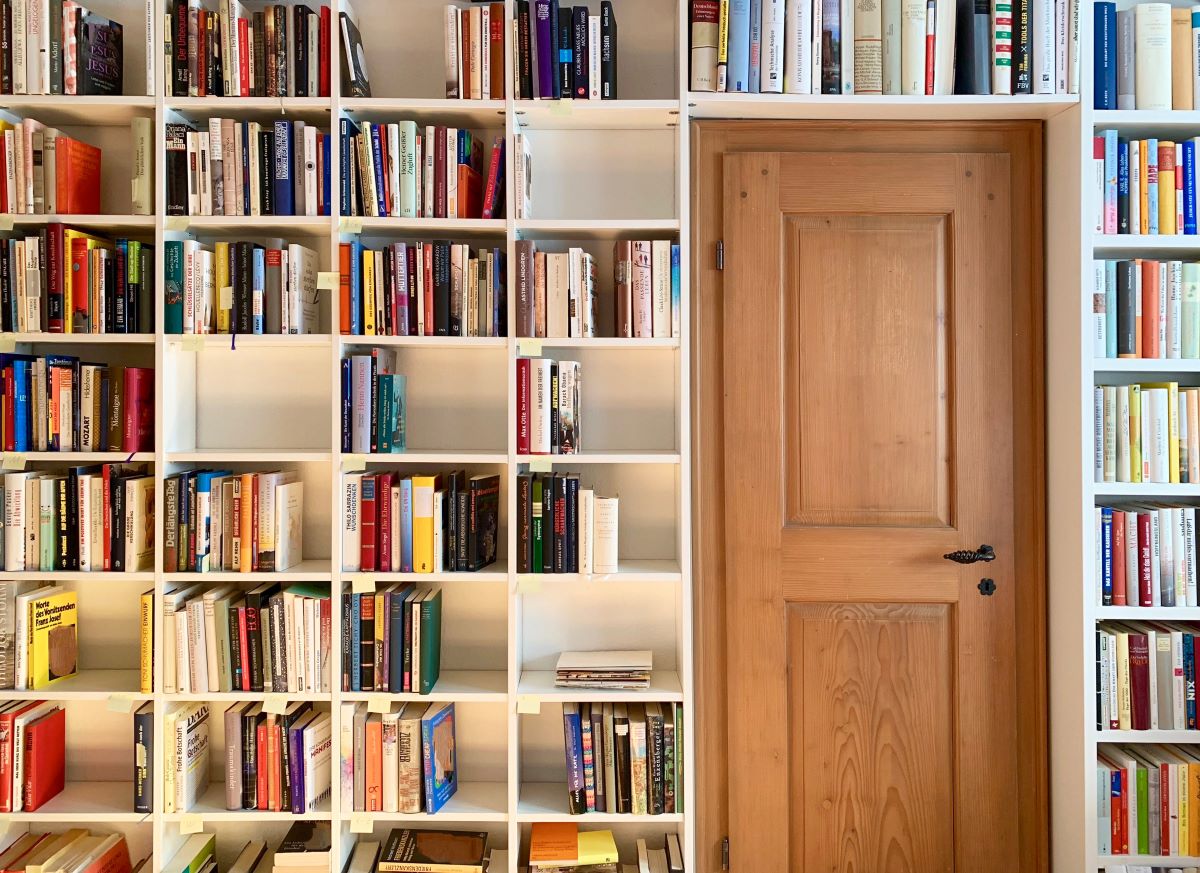

Articles
How To Store Rare Books
Modified: August 28, 2024
Learn how to properly store rare books with these informative articles. Preserve your valuable collection for years to come.
(Many of the links in this article redirect to a specific reviewed product. Your purchase of these products through affiliate links helps to generate commission for Storables.com, at no extra cost. Learn more)
Introduction
Welcome to the world of rare books! Whether you are an avid collector, a book enthusiast, or simply treasure a handful of valuable literary gems, preserving and protecting these precious artifacts is of utmost importance. Proper book storage not only ensures the longevity and condition of your rare books, but also allows you to appreciate and share their beauty for years to come.
In this article, we will explore the essential guidelines and best practices for storing rare books. From choosing the right storage location to handling and organizing your collection, we will cover everything you need to know to maintain the integrity and value of your cherished books.
So, let’s embark on this adventure together and delve into the fascinating world of rare book storage.
Key Takeaways:
- Proper book storage is crucial for preserving rare books, protecting them from damaging factors like humidity, light exposure, and pests. Implementing climate control, security measures, and careful handling ensures their longevity and value.
- Choosing the right storage location, utilizing climate control, and implementing security measures are essential for preserving rare books. Thoughtful organization, proper handling, and avoiding common storage mistakes further safeguard their integrity and value.
Read more: How To Store Books In Garage
Importance of Proper Book Storage
Proper book storage is crucial for preserving the condition and value of rare books. These books are often irreplaceable and hold historical, cultural, or sentimental significance. Without proper storage, they are susceptible to various damaging factors such as humidity, temperature fluctuations, light exposure, and pests.
One of the primary risks faced by rare books is improper handling and storage. Books that are mishandled or stored in unfavorable conditions can suffer from torn pages, broken spines, faded ink, discoloration, and even mold growth. These damages can significantly reduce the value and readability of the books.
Additionally, rare books are often made from delicate materials such as aged paper, vellum, leather, or cloth. These materials are sensitive to environmental changes, and exposure to high humidity, extreme temperature, or direct sunlight can cause irreversible damage. The ink used in older books can also fade or bleed if exposed to harsh light.
Pests like bookworms, silverfish, termites, and rodents are natural enemies of rare books. These creatures can cause significant damage by feeding on pages, bindings, and covers. Furthermore, they may leave behind droppings or excrement, leading to staining and deterioration of the book’s materials.
Lastly, improper storage can result in disorganization and chaos, making it difficult to locate, retrieve, and enjoy your collection. When books are not stored correctly, they may become lost, their condition can worsen, or they may suffer from accidental damage due to improper stacking or placement.
To ensure the preservation and protection of your valuable rare books, it is essential to implement proper storage techniques and preventive measures. By doing so, you can safeguard the integrity, value, and beauty of your collection for generations to come.
Choosing the Right Storage Location
When it comes to storing rare books, selecting the appropriate storage location is paramount. The ideal storage area should provide a stable environment that minimizes exposure to damaging elements.
First and foremost, consider the climate of the storage location. Ideally, the area should have a temperature range between 60 to 70 degrees Fahrenheit (15 to 21 degrees Celsius) with a relative humidity of around 40 to 50 percent. Avoid areas that experience extreme temperature fluctuations or high humidity levels, as these conditions can promote the growth of mold and mildew or accelerate the aging process of the books.
Next, assess the lighting conditions of the storage area. Direct sunlight, as well as strong artificial light, can cause fading and discoloration of book covers and pages. Choose a place with minimal exposure to natural light and install UV-filtered window coverings or shades to protect against harmful UV rays.
It is also vital to select a storage space that is clean, dry, and well-ventilated. Avoid areas prone to leaks, dampness, or excessive dust accumulation. Moisture can lead to mold growth, while dust can settle on the book surfaces and degrade their condition over time.
Furthermore, evaluate the security of the storage location. Ensure that the area has a reliable locking mechanism and limited accessibility to prevent unauthorized handling or potential theft. Consider implementing additional security measures such as installing surveillance cameras or an alarm system to provide extra protection for your collection.
Lastly, it is crucial to find a storage space that offers adequate shelving and storage options. Choose sturdy, book-friendly shelves made of materials such as metal or hardwood to provide proper support and prevent warping or sagging. Ensure that the shelves are adjustable to accommodate books of different sizes and thicknesses.
By carefully considering these factors and selecting the right storage location, you can create an environment that promotes the long-term preservation and protection of your rare books.
Climate Control Considerations
Climate control is an essential aspect of storing rare books, as it helps create a stable environment that mitigates the damaging effects of humidity and temperature fluctuations. Here are some crucial considerations to keep in mind:
Humidity: Maintaining an optimal humidity level is critical for preserving the condition of rare books. High humidity can promote mold growth and accelerate the deterioration of paper, while low humidity can cause the pages to become brittle. Aim for a relative humidity level of around 40 to 50 percent to create a stable environment. To achieve this, you can use dehumidifiers or humidifiers, depending on the climate in your area.
Temperature: Fluctuations in temperature can cause significant damage to rare books. Extreme heat or cold can lead to warping, expansion, contraction, and accelerated aging of the materials. It is best to store books in an environment with a stable temperature ranging between 60 to 70 degrees Fahrenheit (15 to 21 degrees Celsius).
Air Circulation: Proper air circulation is crucial for preventing the buildup of stagnant air, reducing the risk of mold growth. Ensure that your storage area has adequate ventilation and consider using fans or air conditioning units to maintain consistent airflow.
Monitoring and Control: Regularly monitor the temperature and humidity levels in your storage area using thermometers and hygrometers. Consider installing a climate control system with automatic adjustments to maintain the desired conditions. Additionally, there are digital monitoring devices available that can alert you if there are any significant changes in temperature or humidity within your storage space.
Sealing and Insulation: Properly seal and insulate your storage area to prevent the intrusion of outside elements. This helps regulate temperature, humidity levels, and protects against pests. Ensure windows and doors are properly sealed, and consider insulating walls and ceilings to maintain a stable climate within the storage area.
Consider Professional Storage: If controlling the climate in your home or facility proves challenging, you may opt for professional storage services that specialize in preserving rare books. Such facilities usually have advanced climate control systems and expertise in maintaining optimal storage conditions.
By paying attention to climate control considerations, you can create a stable environment that safeguards your rare books from the damaging effects of humidity and temperature fluctuations, ensuring their long-term preservation.
Handling and Inspecting Rare Books
Proper handling and regular inspection of rare books are essential steps in their preservation. Here are some guidelines to ensure the longevity and condition of your collection:
Clean Hands: Always handle rare books with clean, dry hands to prevent oils, dirt, and moisture from transferring onto the pages. Consider wearing soft cotton or latex gloves when handling books with delicate bindings or sensitive materials.
Supportive Handling: Support the spine and covers of the book when handling to avoid putting strain on the binding. Never pull or tug on the pages, as this can cause tears or damage the binding structure.
Avoid Eating or Drinking: Refrain from eating, drinking, or smoking near rare books to prevent accidental spills, stains, or exposure to harmful substances.
Inspect for Damage: Regularly inspect your rare books for signs of damage or deterioration. Look for torn or loose pages, broken hinges, insect infestations, water stains, or mold growth. Early detection of issues allows for prompt repairs and preventive measures.
Proper Bookmarks: Avoid using sharp or metal bookmarks that can damage delicate pages or leave indentations. Instead, use acid-free bookmarks or gently close the book without marking the pages.
Book Rests: When reading or displaying rare books, use book rests or book cradles to avoid over-opening or placing excessive stress on the bindings. These supports help maintain the integrity of the book’s structure.
Proper Lighting: Ensure adequate lighting when examining rare books to maintain visibility without causing excessive strain on the pages. Use soft, diffuse lighting or consider using a book-friendly reading lamp.
Avoid Extreme Conditions: Prevent exposing rare books to extreme temperature and humidity conditions. Avoid storing books in basements, attics, or areas prone to rapid temperature changes to prevent damage to the bindings and pages.
Document and Record: Keep a comprehensive inventory and record any changes or damages that occur over time. This documentation will help you track the condition of your collection and guide future preservation efforts.
By adhering to proper handling techniques and regularly inspecting your rare books, you can minimize the risk of damage and ensure their longevity and continued enjoyment for years to come.
Store rare books in a cool, dry, and dark environment to prevent damage from light, humidity, and pests. Use acid-free materials for storage and handle with clean hands to avoid oils and dirt.
Read more: How To Store Coloring Books
Choosing Appropriate Storage Containers
When it comes to storing rare books, selecting the right storage containers is crucial to protect them from potential damage. Here are some considerations to keep in mind:
Acid-Free and Archival-Quality Materials: Choose storage containers that are made from acid-free and archival-quality materials such as acid-free boxes, folders, or sleeves. These materials are pH-neutral and do not release harmful chemicals that can degrade the books over time.
Size and Fit: Select containers that fit the size of the book comfortably. The container should provide enough space to prevent compression or bending of the book’s pages. Avoid containers that are too tight or too loose, as they can lead to damage or misalignment.
Sturdy and Durable: Opt for containers that are sturdy and can withstand the weight of the books without collapsing or sagging. Look for materials such as acid-free board, polypropylene, or polyester that offer strength and durability.
Protective Enclosures: Consider using protective enclosures such as book jackets, slipcases, or clamshell boxes for added protection. These enclosures shield the books from dust, light, and potential accidents while providing an extra layer of security.
Labeling: Label each storage container with clear and archival-quality labels to easily identify the books within. Use acid-free labels or tags that won’t damage the container or leave adhesive residue.
Stackability: Choose storage containers that are stackable to optimize space and ensure stability. Ensure that the containers are designed to support the weight of additional containers when stacked, reducing the risk of collapsing or shifting.
Pest Prevention: Look for containers that provide some level of pest protection. Some options include containers with tight-fitting lids and seals to keep insects and rodents out, or containers made from materials that are naturally repellent to pests.
Accessibility: Prioritize containers that allow for easy access to the books while minimizing the need for excessive handling. Consider containers with removable lids or book safes that provide convenient access without compromising on protection.
Environmental Considerations: Ensure that the storage containers are designed to withstand environmental changes such as humidity and temperature fluctuations. This prevents the containers from becoming weak, warping, or degrading over time.
Choosing appropriate storage containers is key to safeguarding rare books from environmental factors, pests, and accidental damage. These containers provide a protective home for your collection, ensuring its preservation and longevity.
Arranging and Organizing Rare Books
Properly arranging and organizing your rare books not only enhances their overall aesthetic appeal but also ensures easy accessibility and efficient management of your collection. Follow these guidelines to arrange and organize your rare books effectively:
Categorize by Genre or Subject: Consider organizing your books based on genres, subjects, or themes. This approach allows you to group related books together, making it easier to locate specific titles within your collection.
Alphabetical Order: Arrange your books alphabetically by author or title. This traditional method helps you quickly locate books within your collection and maintain a systematic order.
Numerical Order: If you have a large collection of books from a particular series or set, consider organizing them numerically according to their series or set number. This method ensures that books in a series are stored together and in the correct reading order.
Chronological Order: For books that span different time periods or editions, organizing them chronologically can provide insightful historical context. Arrange them based on publication date or the chronological order of the events they describe.
Size and Format: Group books of similar sizes or formats together, creating a visually pleasing arrangement. This approach also helps prevent unnecessary strain on larger books or delicate bindings when placing them among smaller books.
Shelf Labeling: Use clear and descriptive labels to mark the shelves or storage containers where specific categories or genres are located. This facilitates easy identification and reduces the time spent searching for a particular book.
Consider Usage Frequency: Place frequently accessed or referenced books within easy reach, while books that are less frequently used can be placed on higher shelves or in less accessible areas. This ensures that you can quickly locate and retrieve books that are frequently needed.
Protective Bookends: Use bookends, preferably made of acid-free or non-reactive materials, to provide support and prevent books from leaning or falling over. This helps maintain the integrity of the books and prevents damage to adjacent volumes.
Consider Book Display: Showcase some of your rare or valuable books using bookstands or display cases. This allows you to exhibit their beauty and adds an aesthetic element to your collection’s organization.
Regularly Review and Reorganize: Periodically review your collection and reorganize as necessary. As your collection grows, you may need to make adjustments to accommodate new acquisitions or changes in your priorities.
By arranging and organizing your rare books thoughtfully, you can create a visually pleasing display, optimize access to your collection, and ensure that each book is properly stored and protected.
Implementing Security Measures
Implementing security measures is crucial to protect your rare books from theft, damage, or unauthorized access. Here are some steps you can take to enhance the security of your book collection:
Secure Storage Area: Choose a storage area that has secure locks and limited access. Consider installing a security system, including surveillance cameras and alarms, to deter potential intruders.
Restricted Access: Limit access to your storage area to trusted individuals. Only grant entry to authorized personnel or individuals who have a legitimate reason to access your rare book collection.
Inventory and Documentation: Keep a detailed inventory of your collection, including descriptions, photographs, and any unique identifiers. Maintain records of the value and provenance of each book to aid in identification and recovery in the event of theft.
Insurance Coverage: Obtain appropriate insurance coverage for your rare books. Ensure that your policy adequately covers the value of your collection and includes protection against theft, damage, and natural disasters.
Tracking and Identification: Consider using unique tracking methods such as barcode labels or RFID tags to identify and track your books. This can help deter theft and aid in recovery if any items are lost or stolen.
Secure Internet Access: If you have an online catalog or digital database for your rare books, ensure it is protected with secure access methods. Use strong passwords, encryption, and regular backups to safeguard your digital records.
Security Markings: Consider discreetly marking your books with a unique identifier, such as a custom bookplate, embossed stamp, or invisible ink. These markings can help identify your books if they are ever stolen and subsequently recovered.
Discreet Storage: Avoid advertising the presence of valuable rare books. Keep your collection out of plain sight and refrain from discussing the specifics of your collection with individuals outside of trusted circles.
Provenance Verification: Verify the provenance of any books you plan to purchase or acquire. Be cautious when dealing with sellers who cannot provide proper documentation or proof of ownership.
Inventory Audits: Regularly conduct audits of your collection to ensure that all books are accounted for and in their designated storage locations. This helps identify any missing or misplaced items promptly.
Security Training: Educate yourself and any individuals authorized to handle your rare books on proper security protocols. Make sure they understand the importance of maintaining the confidentiality and safety of the collection.
Remember, implementing thorough security measures is essential to protect your valuable rare book collection. By taking these steps, you can minimize the risk of theft, damage, or unauthorized access, allowing you to enjoy and preserve your books for years to come.
Avoiding Common Mistakes in Book Storage
Proper book storage requires attention to detail and adherence to best practices. To ensure the long-term preservation and protection of your rare books, it’s important to avoid common mistakes that can compromise their condition. Here are some common pitfalls to avoid:
Improper Shelving: Avoid overstacking books on shelves or placing heavy objects on top of them. This can lead to crushing, warping, or damage to the bindings. Ensure that shelves are sturdy and properly aligned to provide adequate support.
Exposure to Direct Sunlight: Direct sunlight can cause fading, discoloration, and deterioration of book covers and pages. Avoid storing your rare books in areas that receive direct sunlight, and consider using UV-filtered window coverings or shades to protect against harmful UV rays.
High Humidity: Excessive humidity can promote mold growth and lead to the deterioration of paper and bindings. Avoid storing rare books in damp or humid areas such as basements or attics. Use dehumidifiers or humidity control devices to maintain optimal humidity levels.
Temperature Extremes: Extreme temperatures can cause warping, expansion, and contraction of book materials. Avoid storing books in areas subject to extreme heat or cold, such as near radiators, air conditioners, or vents.
Improper Handling: mishandling rare books can result in torn pages, broken spines, and other types of damage. Always handle books with clean, dry hands, and support the spine and covers to prevent strain on the binding. Avoid bending or folding pages and never use excessive force when opening or closing a book.
Lack of Dust Protection: Dust can settle on book surfaces and lead to staining and degradation over time. Dust your books regularly using a soft, lint-free cloth or a brush specifically designed for cleaning books. Additionally, consider using dust jackets, slipcases, or protective covers to shield your books from dust accumulation.
Neglecting Pest Control: Pests such as bookworms, silverfish, and rodents can cause significant damage to rare books. Implement preventative measures such as regular inspections, keeping your storage area clean, and using pest repellents or traps if necessary.
Ignoring Regular Inspections: Regularly inspect your rare books for signs of damage, mold, or pests. Early detection can prevent further deterioration and enable prompt actions and repairs.
Lack of Security Measures: Failing to implement appropriate security measures can put your rare books at risk of theft or unauthorized access. Utilize secure storage areas, restricted access, inventory records, and insurance coverage to protect your valuable collection.
Failure to Document and Archive: Neglecting to maintain detailed records, including photographs and descriptions, can make it challenging to track the condition and provenance of individual books. Keep proper documentation and consider digital archiving as a backup for your records.
By avoiding these common mistakes and adopting proper book storage practices, you can ensure the preservation, protection, and longevity of your cherished rare books.
Read more: How To Store Cook Books
Conclusion
Proper book storage is paramount when it comes to preserving the beauty, value, and longevity of rare books. By implementing the guidelines and best practices outlined in this article, you can ensure the protection and enjoyment of your treasured collection for years to come.
We have explored the importance of selecting the right storage location, maintaining climate control, and implementing security measures. We have also discussed the significance of handling rare books with care, choosing appropriate storage containers, and organizing them thoughtfully. Furthermore, we have highlighted common mistakes to avoid to prevent potential damage or loss.
Remember, your rare books hold historical, cultural, or sentimental value. They deserve a proper environment that protects them from damaging elements such as humidity, sunlight, pests, and mishandling. By providing the right conditions and using proper storage techniques, you can ensure the books retain their integrity, aesthetic appeal, and value over time.
As you embark on your journey of preserving your rare book collection, keep in mind that ongoing maintenance and vigilance are key. Regularly inspect your books, monitor the storage environment, and make adjustments as needed. Stay informed about advancements in preservation practices, and continue to educate yourself on how to best care for your rare books.
In the end, the effort you put into proper book storage will be rewarded with a collection that can be enjoyed by you, future generations, and even scholars and enthusiasts. So, take the necessary steps to create the ideal storage conditions, practice careful handling, and organize your collection with care. Your rare books deserve nothing less.
Frequently Asked Questions about How To Store Rare Books
Was this page helpful?
At Storables.com, we guarantee accurate and reliable information. Our content, validated by Expert Board Contributors, is crafted following stringent Editorial Policies. We're committed to providing you with well-researched, expert-backed insights for all your informational needs.














0 thoughts on “How To Store Rare Books”